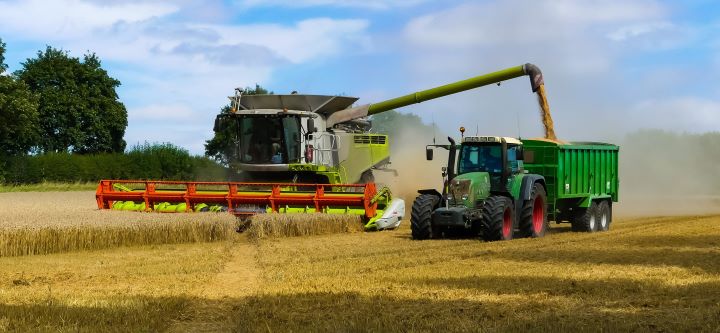George Graham, director at the South Yorkshire Pensions Authority (SYPA), takes stock of their decision to enter into a £260m investment in farmland in collaboration with Royal London Asset Management.

Over the course of a career, there are things you reflect on wondering “how on earth did I ever get involved in that?”. This blog is about one such episode which has received some recent coverage, given its scale and novelty.
South Yorkshire Pensions Authority (SYPA) was the owner of one of the largest single ownership agricultural land holdings in the UK at almost 22,000 acres, which is about 32 square miles. This portfolio, while held as an income generating store of capital, was a bit of an anomaly.
Firstly, we owned the assets directly rather than through a fund. Secondly, we owned some of them through a corporate structure and owned an operating business which farmed most of the land we owned in Cambridgeshire and Norfolk. Yes, the chips for your “chippy tea” and your kids’ Halloween pumpkin might well have been helping pay South Yorkshire’s pensioners!
This made sense in a pre-pooling age when the authority preferred direct investment and had internal investment resources which could devote time to managing this portfolio. But even then, we did not have expertise in agriculture, nor did we have the time and space to actively manage the portfolio beyond acquisitions and disposals. Also, this portfolio as it was constructed did not fit into the pooling agenda at all. At over 2% of the fund and close to a quarter of the overall property portfolio it was too large a holding.
We needed to rethink what we wanted to do with this holding. As the stewards of the business, we needed to consider the best interests of the business as well as our interests as an investor.
The holding has significant untapped potential for emissions reduction, alternative forms of agriculture, renewable energy, and the reuse of redundant farm buildings. None of these could be delivered without further capital running counter to SYPA’s drive to reduce its overall exposure.
The ideal solution for the portfolio would be to bring in further investor(s) and management resource. Back in 2020, when we did a deep dive review of the portfolio this seemed like something of a pipe dream, and we focused on making some smaller changes and improvements that would move things in the right direction. However, we were approached in 2021 by Royal London (RL) with a view to creating a form of joint venture (JV) around the portfolio.
Given RL’s status as a mutual with a long-term investment focus as well as their broader commitment to investing responsibly, it was relatively easy for members of the authority to endorse the principle of creating some form of JV.
As with any project of this sort, we then needed to give it a name. We came up with ‘Project Chip’, recognising one of the major crops produced from the holding.
Steps in the journey
That much was easy, the next step of talking to the lawyers less so. The shared endpoint was easy to agree – some form of legal structure to hold the investments with SYPA as a minority investor and with the ability to bring in third party investors in due course.
The main difficulty was finding a way to create a tax efficient structure that could encompass both the landholdings, whether owned directly or through the corporate entity, and the operating business which farms some of the land under lease agreements. We went through seemingly endless variations on structures including some quaintly named offshore options, before fixing on an English Limited Partnership as an overall wrapper for a Jersey Property Unit Trust (JPUT) holding all the property assets and directly owning the operating company. The meetings with what felt like a dozen lawyers on each side to hash this out are burned into my memory.
Having agreed the legal structure, next came the due diligence process. This is where corporate lawyers and corporate finance experts used to dealing in M&As of FTSE listed companies came up against a £15m turnover farming business which is very good at farming, but perhaps less focused on the minutiae of the risks involved in a corporate takeover. The nature and depth of the questions, which were clearly appropriate for a much larger company, put a considerable strain on the limited resources of the operating company in providing answers. Nonetheless we seem to have answered all the very many questions and by the close of the process there were several thousand documents in the data room.
While this was going on the property conveyancing process was also taking place. To simplify matters it was agreed early on that we would use certificates of title for this rather than working from the individual titles. This is a process commonly used for commercial property. However, it appears it is not so commonly used for agricultural land; indeed, this may have been a first for the lawyers. Everyone was largely learning through doing, including learning how to scan some very pretty 17th century deeds. We also faced challenges in obtaining some of the local authority highway searches. The strong local knowledge of our managing agent and a friendly insurance company quickly addressed this risk to the programme.
Simultaneously, RL were developing their business plan and engaging with academics to fully understand the environmental potential of the land involved and the options available to exploit it. We were also completing a small number of strategic acquisitions which had been in negotiation for several years to maximise the potential efficiencies that can be achieved through marrying up adjoining land.
Reflecting the JV nature of what we were seeking to achieve, RL and ourselves managed progress through a weekly Friday afternoon Teams call, variously involving different members of the team dialling in from cars, trains and buses as well as home and office.
As with many major projects I have been involved with, the final run up to completion all seemed a bit of a rush with the two legal teams seeming to become nocturnal for the last three weeks or so. Or maybe they just weren’t sleeping in order to get the fine detail of the various legal agreements sorted out. Then we had the fun of signing – giving our SYPA seal more exercise than it has had in years.
With the deal being completed, SYPA has managed to reduce its exposure to agriculture to a level consistent with our overall investment strategy while protecting the integrity of the portfolio we had spent so many years building up. There is also now a programme in place which will deliver on the environmental potential of the portfolio and improve the capital stock while continuing to contribute to UK food security.
Key takeaways
What have I learnt from the experience? Firstly, that there are times when local government has simpler decision-making processes than the private sector. RL had to get approval from several different internal committees for the transaction whereas we had a much simpler process. On the other hand, if they were managing SYPA’s money, I would want them to have a process that gave any significant transaction (particularly one valued at c£260m) a thorough review, and of course they are now managing SYPA’s money.
Secondly, I probably ought to know more about tax. When I passed my CIPFA exams in 1990 there was little if anything about tax in the syllabus because local and health authorities only needed to deal with VAT and that was simple. Thankfully the syllabus has changed but for me and I suspect others of my CIPFA generation the landscape has changed, and we need to update our knowledge.
Finally, I realised the importance of having the right advisers and people to manage the detail of a project of this sort which has many moving parts and involves several independent entities. I was in large part, thanks to the ability to procure through the national LGPS frameworks, very lucky in this and we certainly wouldn’t have got the whole project over the line without the hard work and immense knowledge of the lawyers and accountants who advised us on what, even for them, was an unusual project both in terms of its nature and scale.
So, was something like 2 ½ years’ work worth it? Undoubtedly, we can put a tick next to each of the objectives which we set out at the beginning, and we have created a cornerstone investment not just for our natural capital portfolio but hopefully for other LGPS investors to come and join in due course.
—————
FREE bi-weekly newsletters
Subscribe to Room151 Newsletters
Follow us on LinkedIn
Follow us here
Monthly Online Treasury Briefing
Sign up here with a .gov.uk email address
Room151 Webinars
Visit the Room151 channel














